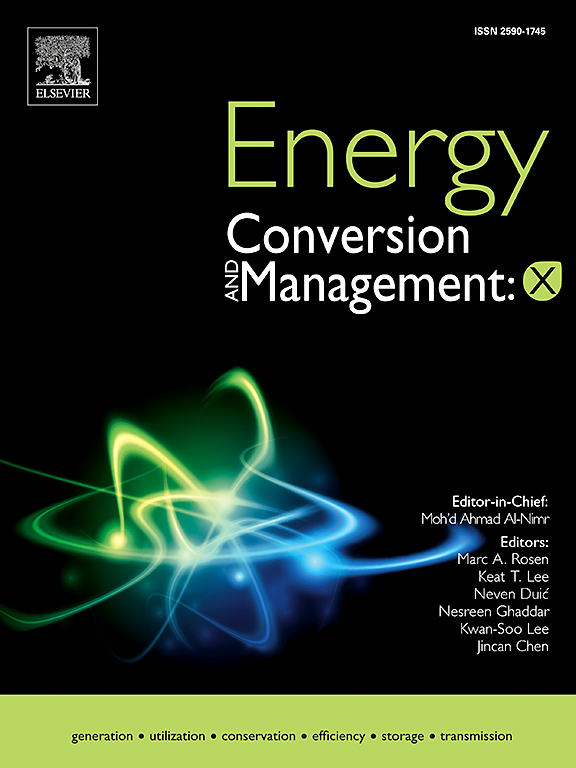Aircraft performance of a novel SAF: Lower costs, lower environmental impact, and higher aircraft performance
IF 7.1
Q1 ENERGY & FUELS
引用次数: 0
Abstract
Investing in Sustainable Aviation Fuel (SAF) is crucial for reducing the aviation industry’s carbon footprint and mitigating climate change. As global air travel demand increases, SAF offers a viable solution to significantly lower greenhouse gas emissions and enhance energy security, ensuring a more sustainable future for aviation. Additionally, converting biomass, particularly waste materials, into SAF adds value by turning potential environmental liabilities into valuable energy resources, promoting a circular economy and reducing overall waste. This study evaluates the aircraft performance of a novel sustainable aviation fuel (SAF) derived from multiple feedstocks in a hybrid biorefinery. SAF performance is compared to two conventional jet fuels, specifically a blend of 30% kerosene and 70% gasoline and JET-A1. The results demonstrated that the optimal SAF outperformed conventional fuels in terms of both thrust and range. Specifically, SAF exhibited a 17% increase in thrust and a 10% increase in range compared to conventional Jet A1 fuel. This novel fuel did not only mitigate CO2 emissions and achieve a cost reduction of 0.13 to 8.08%, but also exhibited superior aircraft performance. In addition, this fuel also meets the criteria of a “drop-in fuel” as it does not necessitate significant alterations to the currently existing CFM56-7B turbofan engine. This is due to its similar key thermodynamic indicators, such as heat capacities and combustion temperature, which are comparable to those of conventional jet fuels. In addition, this paper identifies the sensitivity of the CFM56–7B turbofan engine fuelled by the novel fuel.
新型 SAF 的飞机性能:更低的成本、更小的环境影响和更高的飞机性能
投资可持续航空燃料(SAF)对于减少航空业的碳足迹和减缓气候变化至关重要。随着全球航空旅行需求的增加,可持续航空燃料为大幅降低温室气体排放和提高能源安全提供了可行的解决方案,从而确保航空业拥有更加可持续的未来。此外,将生物质(尤其是废料)转化为 SAF 还能将潜在的环境责任转化为宝贵的能源资源,促进循环经济并减少整体浪费,从而实现增值。本研究评估了一种新型可持续航空燃料(SAF)在混合生物炼制过程中从多种原料中提取的飞机性能。将 SAF 的性能与两种传统喷气燃料(特别是 30% 煤油和 70% 汽油的混合燃料)和 JET-A1 进行了比较。结果表明,最佳 SAF 在推力和航程方面都优于传统燃料。具体来说,与传统的 Jet A1 燃料相比,SAF 的推力增加了 17%,航程增加了 10%。这种新型燃料不仅减少了二氧化碳排放,降低了 0.13% 至 8.08% 的成本,还表现出卓越的飞机性能。此外,这种燃料还符合 "即插即用燃料 "的标准,因为它无需对现有的 CFM56-7B 涡扇发动机进行重大改动。这是因为其关键热力学指标(如热容量和燃烧温度)与传统喷气燃料相似。此外,本文还确定了使用新型燃料的 CFM56-7B 涡扇发动机的敏感性。
本文章由计算机程序翻译,如有差异,请以英文原文为准。
求助全文
约1分钟内获得全文
求助全文
来源期刊

Energy Conversion and Management-X
Multiple-
CiteScore
8.80
自引率
3.20%
发文量
180
审稿时长
58 days
期刊介绍:
Energy Conversion and Management: X is the open access extension of the reputable journal Energy Conversion and Management, serving as a platform for interdisciplinary research on a wide array of critical energy subjects. The journal is dedicated to publishing original contributions and in-depth technical review articles that present groundbreaking research on topics spanning energy generation, utilization, conversion, storage, transmission, conservation, management, and sustainability.
The scope of Energy Conversion and Management: X encompasses various forms of energy, including mechanical, thermal, nuclear, chemical, electromagnetic, magnetic, and electric energy. It addresses all known energy resources, highlighting both conventional sources like fossil fuels and nuclear power, as well as renewable resources such as solar, biomass, hydro, wind, geothermal, and ocean energy.
 求助内容:
求助内容: 应助结果提醒方式:
应助结果提醒方式:


